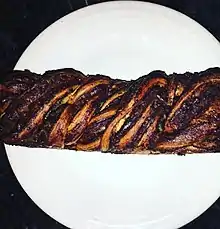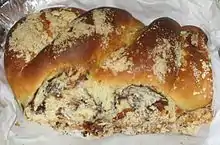Babka
A babka is a sweet braided bread or cake which originated in the Jewish communities of Poland and Ukraine.[5][6][7][8] It is popular in Israel and in the Jewish diaspora. It is prepared with a yeast-leavened dough that is rolled out and spread with a filling such as chocolate, cinnamon, fruit, or cheese and then rolled up and braided before baking.
 A photo of a chocolate babka from Breads Bakery in New York City. | |
| Alternative names | Krantz cake |
|---|---|
| Type | Bread or cake |
| Place of origin | Poland and Ukraine[1][2][3][4] |
| Variations | Chocolate babka, cinnamon babka, apple babka, sweet cheese babka, cinnamon raisin babka |
History
Babka developed in the Jewish communities of Eastern Europe in the early 19th century. Extra challah dough was rolled up with fruit jam or cinnamon and baked as a loaf alongside the challah.[3] Chocolate was not originally used, as it was not generally available; the chocolate babka was likely a mid-20th century American development.[9] Its name (though not necessarily the dish itself) may be related to a type of Easter cake popular in Poland and western Ukraine known as baba or the diminutive babka, which means "grandmother" in Polish, related to the Yiddish bubbe.[3]
Although the Polish and Ukrainian babka are mutually eponymous with their Jewish counterparts, the appearance and preparation of each babka is drastically different. The Eastern European babka draws its name from its tall, stout, fluted sides formed in a traditional pan, and reminiscent of a grandma's skirt. In comparison, the variant introduced to Western culture by emigres to New York consists of strands of rich yeasted dough interwoven and baked in a loaf tin.[10]
The roots of the traditional Slavic babka go back many centuries, with historian and food writer Lesley Chamberlain suggesting that it was a vernacular adaptation of the Italian panettone, imported by the Queen of the Kingdom of Poland, Queen Bona Sforza. Another theory suggests that babka is endemic to Ukraine, where it is an ancient symbol of fertility, prominent in the matriarchal system once in place.[11]
Babka was mostly unheard of outside of the Polish Jewish community until the latter part of the 20th century. European-style bakeries started to offer it in late 1950s Israel and in the US. In addition to chocolate, various fillings including poppy seeds, almond paste, cheese, and others became popular, and some bakers began to top it with streusel.[3]
2010s popularity
Beginning in the 2010s, the popularity of babka increased across the United States, especially in New York, where a handful of traditionally Jewish-owned bakeries and delicatessens began to sell their own versions of babka, filled with traditional fillings such as cinnamon alongside non-traditional fillings such as Nutella and apples, as well as savory variations. They became well known for their chocolate babka.
The newfound popularity of babka across the United States and Canada among both Jews and non-Jews has resulted in many non-traditional variations filled with such fillings as buffalo chicken, rainbow, everything bagel, and cookie butter, among others. Babka has also been featured on restaurant menus and in such dishes as french toast, babka ice cream, and babka ice cream sandwiches, among others.
Babka has become available at grocery stores across the US, with Trader Joe’s offering their own chocolate version made in Brooklyn.[12]
Preparation
It consists of either an enriched or laminated dough; which are similar to those used for challah, and croissants respectively, that has been rolled out and spread with a variety of sweet fillings such as chocolate, cinnamon sugar, apples, sweet cheese, Nutella, mohn, or raisins, which is then braided either as an open or closed plait, topped with a sugar syrup in order to preserve freshness and make the bread moister. It is sometimes topped with a streusel topping.
Variations
American style
American style babka is traditionally made with a dough similar to challah dough and is often topped with streusel, poppy seeds or a crumb topping.
Israeli style
Israeli style babka is made with a laminated dough, enriched with butter, which is then folded and rolled it multiple times to create many distinct layers, similar to that used for Israeli style rugelach, and also croissant dough. Israeli style babka is available with a wider array of fillings and shapes. It is most often shaped into a loaf pan, but it is also sometimes made into individual babkas, a pie-shaped babka, formed into a ring shape, or braided and baked free form or formed into individual twists similar to a cheese straw. The most popular fillings are chocolate which is commonly made with Haschahar Ha'ole, and Israeli chocolate spread, mohn (a sweetened poppy seed paste filling), and sweet cheese typically made with gvina levana. They are rarely topped with a streusel topping. It is typically sweet; however, savory versions are also popular in Israel, often containing labneh and za'atar.[13] It is also often baked as "roses", individual pastries shaped to resemble a rose. They may also be made with a closed plait, versus the more common open plait.[14]
Kokosh
A similar cake called a kokosh is also popular in Jewish bakeries. Kokosh also comes in chocolate and cinnamon varieties, but it is lower and longer than babka, is not twisted, and not topped with streusel. Cakes of these styles are typically, but not universally, considered couronnes baked in loaf pans, rather than babkas. Kokosh has become popular in North American cities with large Jewish populations, including Montreal, New York, Chicago, Miami, and Toronto.
In popular culture
Babka was referenced in the American television series Seinfeld episode "The Dinner Party". Jerry and Elaine stop at Royal Bakery to purchase a chocolate babka while Kramer and George go to buy wine. Jerry and Elaine forget to take a number at the counter. As a result, David and Barbara Benedict, a couple on their way to the same dinner party, get in line ahead of them and purchase the last chocolate babka.[15] Jerry and Elaine resort to purchasing a cinnamon babka, which Elaine considers a "lesser babka". They find that the babka has a hair on it, and are forced to wait in line again to exchange it.[16]
See also
- Brioche
- Coffee cake
- Lekach – Jewish honey cake
- List of desserts
References
- https://openlab.citytech.cuny.edu/ade-sa-martins-eportfolio/2015/12/12/the-history-of-babka-bonus-recipe/
- https://jwa.org/blog/eating-jewish-babka
- Marks, Gil (17 November 2010). Encyclopedia of Jewish Food. HMH. ISBN 978-0-544-18631-6 – via Google Books.
- https://www.theatlantic.com/health/archive/2009/04/babka-trans-atlantic-jewish-delight/716/
- "Ana De Sa Martins's ePortfolio » The History of Babka". Retrieved 2020-09-26.
- October 28; Romanow, 2010 Katherine. "Eating Jewish: Babka". Jewish Women's Archive. Retrieved 2020-09-26.
- Marks, Gil (2010-11-17). Encyclopedia of Jewish Food. HMH. ISBN 978-0-544-18631-6.
- Weinzweig, Ari (2009-04-30). "Babka, Trans-Atlantic Jewish Delight". The Atlantic. Retrieved 2020-09-26.
- Weinzweig, Ari (30 April 2009). "Babka, Trans-Atlantic Jewish Delight". The Atlantic. Retrieved 2020-05-12.
- Marks, Gil (2010-11-17). Encyclopedia of Jewish Food. HMH. ISBN 978-0-544-18631-6.
- Weinzweig, Ari (2009-04-30). "Babka, Trans-Atlantic Jewish Delight". The Atlantic. Retrieved 2020-09-26.
- "Chocolate Brooklyn Babka". What’s Good at Trader Joe’s. Retrieved 3 October 2019.
- Scheft, Uri. Breaking Breads. Artisan.
- Srulovich, Itamar. The Honey & Co. Baking Book.
- "10 Iconic NYC Foods of Seinfeld". Paste. Retrieved 3 October 2019.
- "She Got The Babka". YouTube. Retrieved 3 October 2019. Video of 'The Dinner Party' episode of Seinfeld.
External links
| Look up babka in Wiktionary, the free dictionary. |

